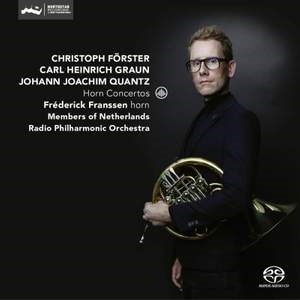
Christoph Förster (1693-1745)
Horn Concerto in E-flat
Carl Heinrich Graun (1704-1759)
Trio sonata in E-flat
Trio sonata in D
Johann Joachim Quantz (1697-1773)
Horn Concerto in E-flat
Anonymous
Concerto in E-flat (attrib. Graun)
Concerto in E flat
Fréderick Franssen (horn)
Members of the Netherlands Radio Philharmonic
rec. 2021, MCO-5 Muziekcentrum van de omroep, Hilversum, The Netherlands
CHALLENGE CLASSICS CC72904 SACD [55]
Note that the headnote omits dates of composition. These six concerti appeared in a manuscript from the “Wenster” collection at the University of Lund in Sweden; all of the composers represented had some personal or professional connection to the city of Dresden. But the program note by soloist Fréderick Franssen shies away from giving any of the scores even approximate dates of composition – the Quantz concerto appears in the 1763 Breitkopf catalogue, but it could have been written well before that.
The program may be “scholarly”, but it’s also a marvelous showcase for Fréderick Franssen, one of the most accomplished hornists I’ve heard. Arpeggios are impeccably “placed”; scalar figures and ornaments – including some high double acciaccature in the Largo of the second anonymous concerto – are clean and articulate; broad lyrical themes are expressively and handsomely voiced. And the player romps through all this with audible relish. More than once, his virtuosity reminded me of Barry Tuckwell, though Franssen’s tone is even better focused without losing warmth, and his definition is even crisper. (That he can be compared to the great Tuckwell at all is a testament to his dexterity and musicianship.)
The opening item, the concerto by Christoph Förster – not to be confused with the Bohemian Romantic, Josef Bohuslav Foerster – incorporates some “advanced” features. The orchestral introduction starts with an appoggiatura or two and is followed by a series of syncopations, all within a firm rhythmic structure. These innovations, taken with Franssen’s authoritative tone – such clear little upward flourishes, such easy high trills – misled me into thinking this was, not a Baroque piece, but a Classical contemporary of Mozart and Haydn’s! The other two movements – the sombre Adagio with its segmented theme, and a bustling Baroque Allegro – are similarly forward-looking: Franssen shines in the former’s high, aspiring lines and the latter’s semiquavers.
The two official Graun scores are trio sonatas, bespeaking a more collaborative approach than full-fledged concerti; they’re more obviously Baroque in style and gesture. In the E-flat sonata – apparently moved from the original D – the horn partners with the violin, unexpectedly joining it in a brief series of trills in the opening Allegretto. The more formal, even grave D major showcases horn and oboe; in the Larghetto, Franssen’s lovely legato doesn’t sacrifice clarity.
The oboe also features in the other works on the program. The strongly grounded central Siciliana, marked by gravitas and tonal weight, is the highlight of the Quantz concerto, and the “chasing-in-circles” finale is fun. I’m not sure why the first of the two anonymous scores was attributed to Graun – nor, for that matter, why the other wasn’t. In the “Graun” piece, the oboe takes the lead in its bracing Allegro – a de facto first movement, preceded by a Largo. The second, despite the presence of an oboe or two, plays like more of a real horn concerto.
I didn’t make any notes about the engineering – definitely a good sign. Franssen’s horn is forward, but not excessively, and the orchestra registers firmly; any ambience is helpful rather than obtrusive. Strongly recommended.
Stephen Francis Vasta
stevedisque.wordpress.com/blog
Help us financially by purchasing from





















